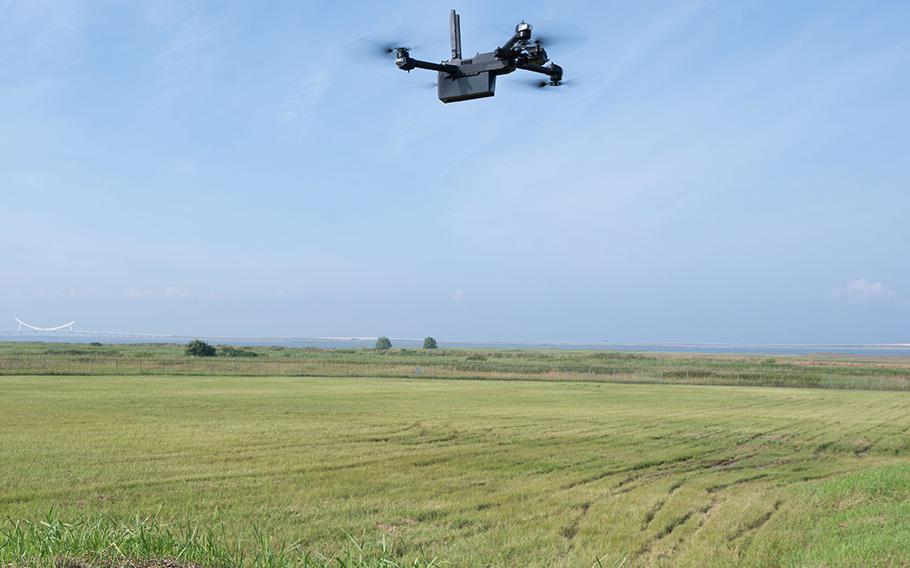
A Skydio X2 drone comes in for a landing at Kunsan Air Base, South Korea on Aug. 18, 2022. (Akeem Campbell/U.S. Air Force)
As the two Koreas near the anniversary of the start of their conflict in 1950, both sides are pouring money into drone programs to bolster their militaries along a border dubbed "the Cold War's last frontier."
South Korea's cabinet this week approved plans for a new drone command to be set up by the military around September to provide what the government called an "overwhelming response" to any provocations by North Korea's unmanned aerial vehicles, or UAVs.
North Korea appears to have started testing a new large drone at its Panghyon air base, NK News reported last week based on satellite images. The aircraft was the largest it has seen to date, with an estimated wingspan of about 115 feet (35 meters), bigger than the 65-foot drone spotted at the air base earlier this month, it said.
South Korean President Yoon Suk Yeol and North Korean leader Kim Jong Un have let each other know that they intend to step up their drone programs, setting the stage for an escalation after each sent the aircraft across the border in December. That marked a first in the conflict between the two states that started on June 25, 1950, and was halted through an armistice about three years later.
Russia's war in Ukraine has shown how drones can be used quickly and cheaply to survey the battlefield, deploy small explosives and strike fear in an adversary. For North and South Korea, drones could prove invaluable along a border where each positions hundreds of thousands of soldiers.
"Drones are currently hitting that spot of being threatening and menacing without yet creating full-blown, open hostilities that could have broader geopolitical ramifications," said Beryl Pong, a faculty member at the University of Cambridge and the National University of Singapore specializing in contemporary warfare.
In a landmark speech Kim made in 2021 a congress of his Workers' Party of Korea just before President Joe Biden took office, the North Korean leader laid out his weapons priorities for the coming years. That included new missiles to deliver nuclear warheads to the U.S. mainland, hypersonic glide vehicles and reconnaissance drones.
His state has not officially unveiled any new UAV or combat drone designs since 2012, according to NK News. The U.S. Defense Intelligence Agency said in its most recent report on North Korea's military power that Kim's regime has been flying drones near the border based on Chinese commercial designs and using Chinese components.
Drones could be a far cheaper way for North Korea to keep an eye on military activities on the other side of the 250 km border between the two Koreas than the spy satellite Pyongyang tried to launch in May on a rocket that failed in flight.
North Korea is repaving a launchpad at its space rocket facility after saying it intends to try again soon to place a spy satellite into orbit, NK News reported based on satellite imagery.
North Korea's UAV programs have been active for years, "but in contrast to their many other military achievements, they remain largely unseen and secretive," said Joseph Dempsey, a research associate for defense and military analysis at the International Institute for Strategic Studies.
North Korea has shown that its "small, uncomplicated UAV types based on off-the-shelf commercial technologies can successfully penetrate and operate within South Korean airspace with relative ease," he said.
Dempsey said there are questions over whether North Korea has long-range electrooptical sensors to allow for reconnaissance across the border. The greater concern is that North Korea might try to develop its smaller drones into one-way weapons, which could provide a cheaper alternative to cruise missiles, he said.
South Korea received a wake-up call about the threat when Kim's regime sent five drones across the border in late December, including one that flew near the Presidential Office in Seoul. South Korea's military tried and failed to shoot the devices down. One complicating factor in that effort was a reluctance to fire munitions in heavily populated areas around the capital city.
Shortly after the episode, South Korea unveiled a plan to spend about 560 billion won ($432 million) over the next five years on drones, including systems to bring down those from adversaries. The new command will conduct surveillance, electromagnetic warfare and military strikes, Yonhap News reported.
North Korea's UAVs pose a new type of threat for South Korea's military, one that will be difficult for the current missile defense architecture to handle, said Yoon Sukjoon, a retired captain in South Korea's navy who is a senior fellow at the Korea Institute for Military Affairs.
"UAVs appear to be a future tool for conducting operational and tactical operations," Yoon said, adding that they appear to be sparking "a new arms race between two Koreas."
Bloomberg's Shinhye Kang contributed to this report.